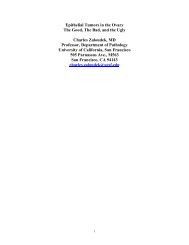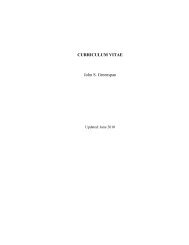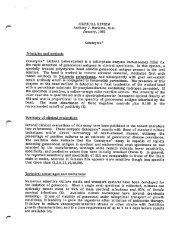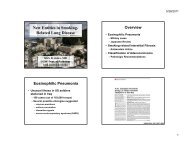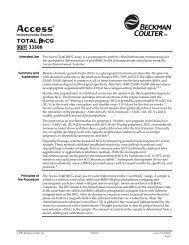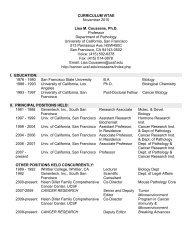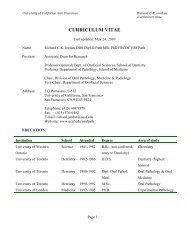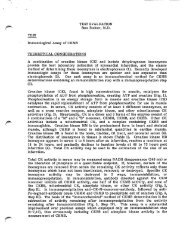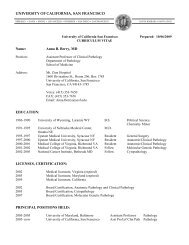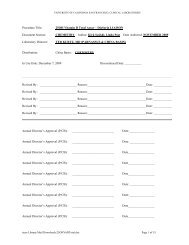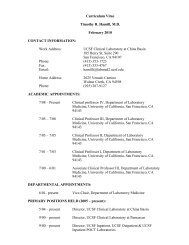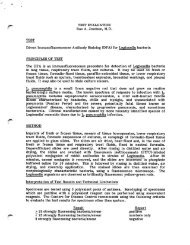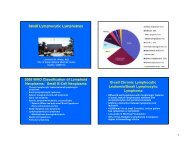CREATINE KINASE ISOENZYME MB A Critical Review by Wendy ...
CREATINE KINASE ISOENZYME MB A Critical Review by Wendy ...
CREATINE KINASE ISOENZYME MB A Critical Review by Wendy ...
You also want an ePaper? Increase the reach of your titles
YUMPU automatically turns print PDFs into web optimized ePapers that Google loves.
<strong>CREATINE</strong> <strong>KINASE</strong> <strong>ISOENZYME</strong> <strong>MB</strong><br />
A <strong>Critical</strong> <strong>Review</strong> <strong>by</strong> <strong>Wendy</strong> Ward, M.D.<br />
September 30, 1988<br />
Creatine kinase isoenzyme <strong>MB</strong> (CK <strong>MB</strong>) is a more sensitive and<br />
specific serum marker of acute myocardial injury (AMI) than the<br />
older, alternative laboratory assays; total CK, LD, and AST.<br />
Total CK, LD, and AST are notoriously nonspecific enzymes. Even<br />
minor trauma releases CK from skeletal muscle. LD, present in all<br />
organs, is elevated in serum after any organ injury, in<br />
carcinomatosis, and in various anemias. AST, too, is elevated in<br />
a spectrum of clinical situations other than AMI, including liver<br />
disease, biliary obstruction, muscle disease, and trauma.<br />
Likewise, electrocardiography, lacks specificity and sensitivity<br />
in the diagnosis of acute MI. Authentic infarctions often show<br />
only nonspecific EKG changes, which cannot be distinguished from<br />
those seen in angina. Q-waves, although specific, are not always<br />
present in acute MI, so lack sensitivity.<br />
Assay of CK <strong>MB</strong>, on the other hand, is an extremely specific test<br />
for the diagnosis of AMI.^'J'4'a CK <strong>MB</strong> is highly.concentrated in<br />
myocardial tissue in comparison to other tissues. During<br />
myocardial injury, CK <strong>MB</strong> is released from ischemic myocardial<br />
cells, and is significantly increased in the serum four to six<br />
hours after the onset of symptoms. Serum levels of CK <strong>MB</strong> reach a<br />
peak within 12 to 24 hours after infarction. The elevation<br />
persists from 48 to 72 hours. 'J Only when patients are admitted<br />
later than 72 hours after the onset of cardiac symptoms, is LDH-1<br />
a more appropriate assay. LDH 1 peaks at 48 to 72 hours-after the<br />
infarct and remains elevated for one to two weeks. '' The<br />
majority of patients, however, present with ongoing chest pain of<br />
recent onset. CK <strong>MB</strong> is currently the laboratory assay of choice<br />
for diagnosing or ruling out acute MI in these patients.<br />
Several CK <strong>MB</strong> assay methods are currently available, and new<br />
options are being developed rapidly. Electrophoretic separation<br />
>f CK isoenzymes was the original method and is still the gold<br />
tandardin many labs. If total CK activity is assayed in<br />
< onjunction with electrophoresis, the percentage of CK <strong>MB</strong> measured<br />
1 / scanning the CK <strong>MB</strong> band with a densitometer can be used to<br />
c ilculate approximate activity due to the <strong>MB</strong> isoenzyme.<br />
R grettably, CK isoenzyme electrophoresis^ has numerous<br />
d. sadvantages. It is a cumbersome, time-consuming laboratory test.<br />
Ir many hospitals, it is not available in evenings or on weekends.<br />
Me mwhile, patients must be held in expensive cardiac care unit<br />
ho pital beds, awaiting results from the next routine laboratory
f s h i f t .<br />
Furthermore, electrophoresis is semi-quantitative, at best, and<br />
lacks sensitivity in low ranges of CK <strong>MB</strong>. A CK <strong>MB</strong> band is only<br />
visualized when serum CK <strong>MB</strong> fraction reaches 3% to 4% of total CK.<br />
The ability to visualize a CK <strong>MB</strong> band is generally interpreted as<br />
evidence of MI. Using this cutoff range, a large number of false<br />
positives are found among healthy subjects. '4 Most laboratories<br />
decide upon a lower limit of total CK, below which they refuse to<br />
fractionate isoenzymes in attempt to reduce false positive<br />
reporting. Commonly, the upper limit of the 95% confidence<br />
interval for the total CK reference range is chosen as the lower<br />
limit for indicating CK isoenzyme electrophoresis.<br />
A more recent method of CK <strong>MB</strong> assay, which is now offerred <strong>by</strong><br />
Kodak Ektachem, uses anti-human CK-M antibody to inhibit CK-M<br />
subunit_activity. The remaining CK-B activity, in most cases, is<br />
proportional to CK-<strong>MB</strong> activity. Activity is measured using<br />
creatine phosphate and ADP as substrates to generate creatine and<br />
ATP. In a coupled reaction sequence, hydrogen peroxide oxidizes a<br />
dye precursor. The rate of chromophore production, measured <strong>by</strong><br />
reflectance spectrophotometry at 670 nm, is proportional to CK <strong>MB</strong><br />
activity.<br />
creatine kinase<br />
c r e a t i n e p h o s p h a t e + A D P > c r e a t i n e + A T P<br />
N-acetylcysteine<br />
glycerokinase<br />
A T P + g y l c e r o l > L - a l p h a - g l y c e r o p h o s p h a t e + A D P<br />
L-alpha-glycerophosphate oxidase<br />
L - a l p h a - g l y c e r o p h o s p h a t e + 0 2 > d i h y d r o x y a c e t o n e<br />
phosphate + H,0,<br />
peroxidase 2 2<br />
H 2 ° 2 + d y e P r e c u r s o r > d y e + 2 H 2 0 2<br />
Although this method is rapid, sensitive and inexpensive, it is<br />
subject to several interferences which lead to false positives.<br />
The false positive rate has been reported to be 5.3%, the majority<br />
of which are caused <strong>by</strong> excess CK BB. A small number of false<br />
positives are caused <strong>by</strong> macro CK. Rarely, mitochondrial CK is<br />
responsible for a false positvive. Nevertheless, sensitivity<br />
approaches 100%. Many laboratories believe that the Ektachem CK<br />
M immunoinhibition assay is an excellent screening tool for the<br />
specific use of rapidly excluding the diagnosis of acute MI, and<br />
allowing rapid dismissal of patients from the cardiac care unit<br />
during late hours and weekends. Most laboratories, however, feel<br />
that it is necessary to confirm positive Ektachem results with a<br />
more specific CK <strong>MB</strong> assay, such as CK isoenzyme electrophoresis,<br />
or another immunoassay.<br />
Recently, immunodiagnostic methods to assay CK <strong>MB</strong> in mass units,<br />
rather than units of enzyme activity have been developed and are<br />
offered as highly specific tests for the diagnosis of acute MI, or
f a s c o n fi r m a t o r y t e s t s . T h e c l e a r a d v a n t a g e o f t h e s e a s s a y s o v e r<br />
electrophoresis is ease and speed of performance. Mass<br />
measurement of CK <strong>MB</strong> is inherently more accurate and specific than<br />
assays of enzyme activity. The potential for interference <strong>by</strong><br />
adenylate kinase, which necessitates inhibitory steps in enzymatic<br />
assays, is totally eliminated <strong>by</strong> mass measurement. Furthermore,<br />
mass concentration assays, <strong>by</strong> RIA, EIA, or chemiluminescence,<br />
utilize anti-CK M and anti-CK B to sandwich CK <strong>MB</strong>, or they utilize<br />
new monoclonal anti-CK <strong>MB</strong> antibodies. '3 Interference <strong>by</strong> CK BB.<br />
excess CK MM, macro CK or other forms is virtually eliminated. '5<br />
False negatives could theoretically result, if CK BB is present in<br />
concentrations high enough to saturate all the anti CK B provided<br />
in the kit. This would be an uncommon clinical situation. CK BB<br />
is present in appreciable quantities only in the brain, and is<br />
prevented from entering circulating blood <strong>by</strong> the blood brain<br />
barrier, even in cases of head trauma and CVA. Occasionally, CK BB<br />
is elevated in association with certain carcinomas, in which case<br />
the clinician should anticipate the possibility of interference.<br />
Ciba Corning has recently placed an immunochemiluminometric assay<br />
of CK <strong>MB</strong> on the market, which provides a representative model of<br />
the many new mass concentration immunoassays. This system is<br />
selected for discussion here because of the apparent time<br />
advantage it offers over two site sandwich capture assays<br />
^ ( c u r r e n t l y o f f e r e d b y H y b r i t e c h , a n d B e h r i n g ) . T h e<br />
(; immunochemiluminometric method utilizes a magnetic bead,<br />
covalently bound to anti-CK B, which provides a solid support.<br />
When added to serum, all CK BB and CK <strong>MB</strong> is bound <strong>by</strong> the magnetic<br />
particles. The magnetic particle-CK <strong>MB</strong> and CK BB complexes, are<br />
magnetically held to the sides of the test tube while free CK MM<br />
is washed off. A monoclonal antibody to CK <strong>MB</strong>, labelled with<br />
acridinium ester is also utilized. It binds only to CK <strong>MB</strong>, which<br />
is bound and immobilized <strong>by</strong> the magnetic beads. Excess labelled<br />
anti-CK <strong>MB</strong> is removed through vortexing and rinses. Quantitation<br />
of CK <strong>MB</strong> is effected through addition of H-0. to activate<br />
chemiluminescent photon emission from the acridinium label, and<br />
measurement with a luminometer. Photon emission is proportional<br />
to the amount of CK <strong>MB</strong> present in the specimen (Figure 1).<br />
The immunochemiluminometric assay correlates well with<br />
electrophoresis, r = .938 and with immunoenzymatic assays, r =<br />
.942. The assay is extremely sensitive, able to detect 1 ug/L CK<br />
<strong>MB</strong>, and therefore minimizes false negatives. Sensitvity and<br />
specificity are reported to be 94% <strong>by</strong> Ciba Corning Diagnostic<br />
Corp.<br />
In summary, CK <strong>MB</strong> assays, of crucial importance to CCU's, have<br />
undergone extensive evolution and improvement in the last several<br />
years. Laboratories and hospitals should be aware and receptive<br />
of new immunoenzymatic and mass concentration immunoassay options.<br />
^ W h e n<br />
STAT<br />
a p p l i<br />
screening<br />
e d i n a<br />
with<br />
t h o u<br />
Ektachem<br />
g h t f u l s c<br />
CK<br />
r e e n<br />
<strong>MB</strong><br />
i n g /<br />
slides<br />
c o n fi r m<br />
and<br />
a t i o<br />
confirmation<br />
n s t r a t e g y<br />
with<br />
( e . g .<br />
Ciba Corning immunochemiluminometric methods), these new assays<br />
can expediate results, save unnecessary CCU days, and contain
laboratory costs, with improved sensitivity and specificity.<br />
/!ifcSy<br />
/^^\<br />
Figure 1<br />
CK Isoenzymes C K - M M M ^ M<br />
CK-B8 \£}^<br />
C K - M B ~ H B<br />
-< E-0<br />
e L r T ) / ^ N<br />
yW<br />
-^ + &0 +ny<br />
^< &e )Mq<br />
Lite Reagent. Antigen Solid Phase<br />
AE-LaDeiea in Patient Monocionai Antmoav<br />
M o n o c l o n a l S a m o i e ! o C K - 8 B B o u n a t o<br />
A n t i D o a y t o C K - M B P a r a m a g n e t i c P a r t i c i e s<br />
.**» I -A1 r<br />
l^K£)))=Q<br />
->r*i lSa<br />
0®^[-K->©<br />
Separate<br />
& Measure
BIBLIOGRAPHY<br />
Allbright, A., editor. Clinical Laboratory Manual, San<br />
Francisco General Hospital Medical Center. 28th edition.<br />
1988.<br />
2 R. Roberts. "Enzymatic Diagnosis of Acute Myocardial Infarction."<br />
Chest. Vol. 93. 1988. 3s-6s.<br />
3 J. Lott, J.Stang. "Serum Enzymes and Isoenzymes in the Diagnosis<br />
and Differential Diagnosis of Myocardial Ischemia and<br />
Necrosis." Clinical Chemistry. Vol. 26:9. 1980. 1241-1250.<br />
T. Koch, U. Mehtz, H. Nipper. "Clinical and Analytical<br />
Evaluation of Kits For Measurement of Creatine Kinase<br />
Isoenzyme <strong>MB</strong>." Clinical Chemistry. Vol 32:1. 1986.<br />
186-191.<br />
5 .<br />
Piran, Kohn, Uretsky, Bernier, Barlow, Niswander, stastny.<br />
"Immunochemiluminometric Assay of CK <strong>MB</strong> with a Monoclonal<br />
Antibody to the <strong>MB</strong> Isoenzyme." Clinical Chemistry. Vol.<br />
33:9. 1987. 1517-1520.<br />
g J. Sanderson. Recent Advances in the Measurement of CK-<strong>MB</strong> By<br />
Immuno-inhibition. (Seradyn, Inc: Indianapolils, IN).<br />
1983.<br />
7 C. Greiner, C. Leiendecker-Foster, M. Basara, K. Willard.<br />
"An Efficient Testing Strategy Using the Ektachem CK-<strong>MB</strong>."<br />
Clinical Chemistry. Vol 32:6. 1988. Abstract #631.<br />
T. Green. "Evaluation of Seradyn CK <strong>MB</strong> reagent on the Monarch<br />
761." Veterans Administration Medical Center. Portland,<br />
Oregon. 1988.<br />
9 Henry, J., editor. Todd. Sanford. Davidsohn; Clinical Diagnosis<br />
and Management <strong>by</strong> Laboratory Methods. (W.B. Saunders Co.:<br />
Philadelphia). 1979. pp. 372-374.



